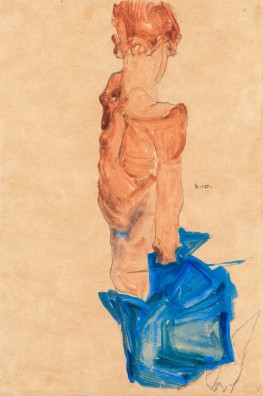Catalogue en ligne
3 avril 2025 - une collection privée suisse
Helmut Weiss, Deutschland
Jane Kallir, Egon Schiele, The complete works, New York, Harry N. Abrams, 1990, S. 399, Nr. 447.
Österreichische Aktzeichnungen von Klimt bis heute: Im Gedenken an Herbert Boeckl, Wien, Secession, 1969, Nr. 64.
The work, created in 1910, falls within a period of radical stylistic development in Schiele’s work: the complete liberation from his mentor Gustav Klimt towards his own expressive imagery. Schiele himself described this metamorphosis in a letter written that same year: “Until March, I followed Klimt’s path. Today, I believe I am his opposite.” The present work, which marks the culmination of these experiments, combines intense observation of the human figure with the artist’s unique, expressive stylization into a dynamic, literally visceral representation of the body. Although the artist was only twenty years old at the time, this was the beginning of his maturity. The Back View of a Boy is a work of complete independence, and although the term “genius” should be used with great caution, it is certainly appropriate in Schiele’s case. What we see is an unprecedented emphasis on the expressive possibilities of contour and brushwork. Schiele fills the frame with his feverish lines and glazing colors, using the brush to create mass, texture and a sense of vibrancy, achieving subtle color transitions and wet-on-wet effects. The forms, particularly striking in the rendering of the young man’s fabric and skin, are defined by the movements of the paint and give a pulsating liveliness. As with most of his figures, the gaunt and bony body corresponds to the physiognomy of the artist himself and is emblematic of the vulnerability of human existence. Schiele’s nudes and semi-nudes are at the center of his work and are the obsession and elixir of his short career. Adolescents appear repeatedly in Schiele’s work between 1910 and 1911. Not only were they willing to pose for considerably less money than professional artists, but perhaps more importantly for Schiele, they had a certain casualness and informality that allowed him to explore human nature.
Rückenakt eines Knaben mit blauem Tuch, 1910
Aquarell und schwarzer Farbstift auf Papier
rechts der Mitte monogrammiert und datiert S.10.
45,5 x 30,5 cm
CHF 400'000 – 600'000
Helmut Weiss, Deutschland
Jane Kallir, Egon Schiele, The complete works, New York, Harry N. Abrams, 1990, S. 399, Nr. 447.
Österreichische Aktzeichnungen von Klimt bis heute: Im Gedenken an Herbert Boeckl, Wien, Secession, 1969, Nr. 64.
The work, created in 1910, falls within a period of radical stylistic development in Schiele’s work: the complete liberation from his mentor Gustav Klimt towards his own expressive imagery. Schiele himself described this metamorphosis in a letter written that same year: “Until March, I followed Klimt’s path. Today, I believe I am his opposite.” The present work, which marks the culmination of these experiments, combines intense observation of the human figure with the artist’s unique, expressive stylization into a dynamic, literally visceral representation of the body. Although the artist was only twenty years old at the time, this was the beginning of his maturity. The Back View of a Boy is a work of complete independence, and although the term “genius” should be used with great caution, it is certainly appropriate in Schiele’s case. What we see is an unprecedented emphasis on the expressive possibilities of contour and brushwork. Schiele fills the frame with his feverish lines and glazing colors, using the brush to create mass, texture and a sense of vibrancy, achieving subtle color transitions and wet-on-wet effects. The forms, particularly striking in the rendering of the young man’s fabric and skin, are defined by the movements of the paint and give a pulsating liveliness. As with most of his figures, the gaunt and bony body corresponds to the physiognomy of the artist himself and is emblematic of the vulnerability of human existence. Schiele’s nudes and semi-nudes are at the center of his work and are the obsession and elixir of his short career. Adolescents appear repeatedly in Schiele’s work between 1910 and 1911. Not only were they willing to pose for considerably less money than professional artists, but perhaps more importantly for Schiele, they had a certain casualness and informality that allowed him to explore human nature.
